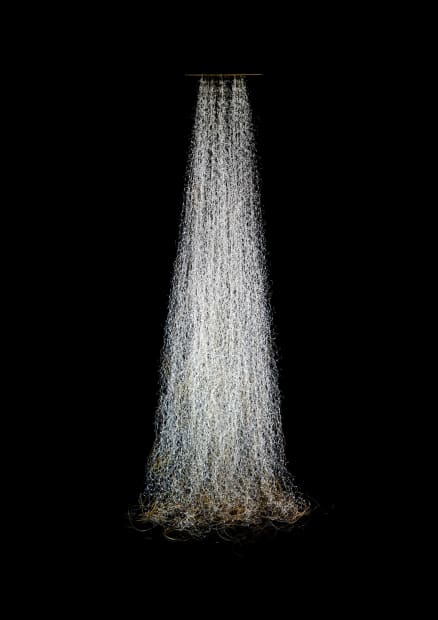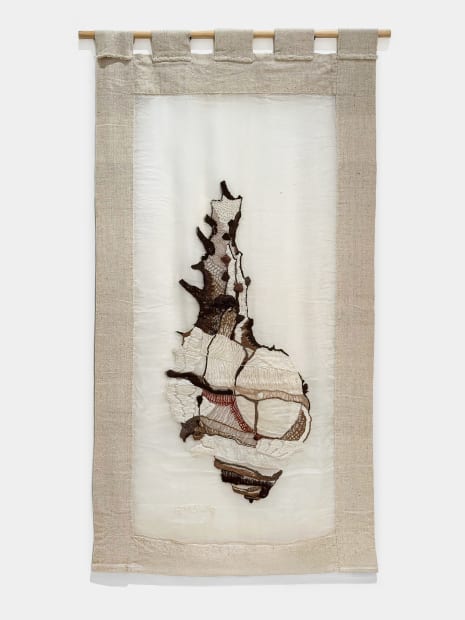-
Pioneering Textile Artists
Yvonne Pacanovsky Bobrowicz (1928-2022)
Nancy Hemenway Barton (1920-2008)
Ferne Jacobs (b. 1942)
Ethel Stein (1917-2018)
-

-
-
 Yvonne Pacanovsky BobrowiczEarth Goddess, 1993Monofilament knotted, gold leaf14 x 9 x 4 in
Yvonne Pacanovsky BobrowiczEarth Goddess, 1993Monofilament knotted, gold leaf14 x 9 x 4 in
35.6 x 22.9 x 10.2 cm$ 14,000.00 -
 Yvonne Pacanovsky BobrowiczCosmic Series Opposites , 1996Clear, black monofilament, gold leaf12 x 12 x 6 in
Yvonne Pacanovsky BobrowiczCosmic Series Opposites , 1996Clear, black monofilament, gold leaf12 x 12 x 6 in
30.5 x 30.5 x 15.2 cm$ 9,000.00 -
 Yvonne Pacanovsky BobrowiczCosmic Miniature , 1990Knotted clear monofilament, brass hardware13 x 12 x 3 in
Yvonne Pacanovsky BobrowiczCosmic Miniature , 1990Knotted clear monofilament, brass hardware13 x 12 x 3 in
33 x 30.5 x 7.6 cm$ 12,000.00
-
-
During the 1960s and 70s Pacanovsky moved from functional woven textiles to sculptural work, and became known for her use of clear, translucent, and opaque monofilament fibers. Since then she has worked exclusively with hand-knotted artworks, culminating with her Cosmic series, sculptural hangings which suggest the ever-expanding universe which she has worked on over several decades. About the Cosmic series the artist writes: “I am concerned with expressing interconnections – interconnectedness and continuum. My work has been combining natural materials with synthetics, relating opposites, randomness and order – dark, light, reflective, opaque, illumination to dematerialization, exploring cosmic energy fields. I have been knotting clear monofilament, a man-made fiber that transmits light, combining it with natural linen, opaque and light absorbent, incorporating gold leaf, reflective and alchemically symbolic – unifying them in a variety of densities, scale, and configurations. Monofilament is a flexible medium – moves with air currents –changes with various lighting, natural, seasonal, and artificial. I am interested in kinetics – dynamic pattern/resultant forms in spacetime. “ A friend and a collaborator of architect Lou Kahn and architect Ann Ting, Pacanovsky was introduced by the latter to concepts of geometric solids, particle physics and Jungian philosophy, which inspired the Cosmic Series. The artist expresses the idea of energy fields and the constant motion of the particles of matter in the universe through the use of knotted clear monofilament, natural linen, and 24 karat gold leaf. Her choices of materials and knotting technique are very deliberate: Curved knots receivingthe vectors of the straight lines, "feminine and masculine principals as referred to by Karl Jung." The knots become particles with the vectors that connect them as "the force of attraction and separation become a cosmic energy field catching the light." Natural linen, symbolic as of the earth, opaque and absorbent, is incorporated to break the density of the particle field. Gold leaf is reflective, precious, and ancient, speaks of alchemy and transcendent value.
-

-

-
Ferne Jacobs
Ferne Jacobs (b. 1942) of Los Angeles has been a leading innovator in fiber art since the 1960s, transforming ancient basket-making techniques into original sculptural forms. Working off-loom with coiled, twined, and knotted waxed linen, she creates solid, organic structures shaped entirely by hand, exploring themes of gender, spirituality, nature, and the tension between interior and exterior space.Originally a painter, Jacobs turned to weaving in the 1960s and began her signature three-dimensional fiber sculptures by 1970. A pioneer of the International Fiber Art Movement, she earned her MFA at Claremont Graduate University, held residencies such as La Napoule, and was a 2024 Loewe Foundation Craft Prize finalist. Her work appears in major permanent collections, including the Metropolitan Museum of Art, the Museum of Arts and Design, the Smithsonian American Art Museum, the MFA Boston, the de Young Museum, and RISD, and she has received multiple NEA Fellowships and honors from the Flintridge Foundation and the American Craft Council.
-
Ethel Stein
Ethel Stein (1917–2018) was an American textile artist known for her masterful drawloom weavings that combined ancient techniques with modernist design. Raised in New York among artists at the Educational Alliance, she gained early exposure to craft and artmaking, later studying life drawing, sculpture, and stage design. In the late 1930s, she taught at Harvard’s Busch-Reisinger Museum and absorbed Bauhaus principles under Josef Albers, an influence that shaped her lifelong focus on geometry, structure, and color.Stein turned to weaving in the 1960s, inspired by friends and local artisans. She moved from utilitarian experiments to highly intricate geometric and figurative textiles, often using continuous warp systems and ikat-dyed edges. Finding standard looms limiting, she engineered her own single-operator drawloom—described as unique by curator Milton Sonday—which enabled her to achieve complex damask, double-cloth, and lampas structures. From 1987 to 1993, she studied historic fabrics at the Metropolitan Museum, deepening her structural expertise.Though she worked quietly and outside trends, Stein gained late-career recognition, culminating in her first retrospective, Ethel Stein, Master Weaver, at the Art Institute of Chicago in 2014–15. She continued weaving into her nineties, relying on touch as her eyesight declined. Stein died in 2018 at age 100; her celebrated loom now resides at the Art Institute of Chicago. -
-
 Ethel SteinIndigo 25, 1988Damask, indigo dyed cotton; woven on a loom with a drawloom attachment fabricated by the artist34 1/4 x 34 1/4 in
Ethel SteinIndigo 25, 1988Damask, indigo dyed cotton; woven on a loom with a drawloom attachment fabricated by the artist34 1/4 x 34 1/4 in
87 x 87 cm -

-
 Ethel SteinBlack and White, 2007Cotton, weft resist dyed (weft ikat) satin damask weave; woven on a loom with a drawloom attachment fabricated by the artist31 x 35 in
Ethel SteinBlack and White, 2007Cotton, weft resist dyed (weft ikat) satin damask weave; woven on a loom with a drawloom attachment fabricated by the artist31 x 35 in
78.7 x 88.9 cm$ 14,000.00 -

-
Art Basel Miami BOOTH S18: MIAMI BEACH, FLORIDA | DEC 3 - 7, 2025
Current viewing_room

























